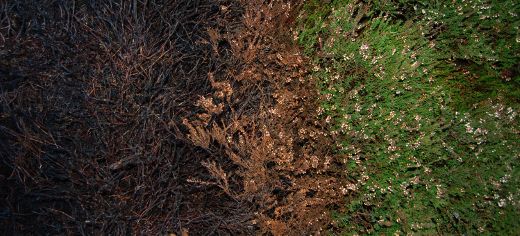
Evidence of the environmental impact of heather burning is published today in the first authoritative study on the subject, to help relieve tensions on both sides of the grouse moor management debate.
The EMBER (Effects of Moorland Burning on the Ecohydrology of River basins) project has shown that heather burning on moorland, which is practised predominantly to support red grouse populations for gun sports, has significant negative impacts on peat hydrology, peat chemistry and physical properties, river water chemistry and river ecology.
A report on the five-year EMBER project is published online today – the first day of the moorland burning season, which will run until 15 April 2015.
Dr Lee Brown, from the School of Geography at the University of Leeds, who led the study, said: "Until now, there was little evidence of the environmental impacts of moorland burning. Yet, many moorland owners and individuals who hold sporting rights to the land have felt pressured by regulators and conservationists to change their burning regimes.
“Unsurprisingly, a push away from moorland burning – a practice that started in the UK about 100-150 years ago – without solid scientific evidence to back up the need for change has created a lot of tension. The findings from the EMBER project now provide the necessary evidence to inform policy.”
The EMBER project assessed the impacts of heather burning on ‘peat uplands’ – moorlands consisting mainly of peat on higher land – by comparing 120 patches of peat in 10 river catchment areas across the English Pennines, with an equal split between burned and unburned areas. The area studied spanned from near Ladybower Reservoir in Derbyshire to Moor House National Reserve, which straddles the border between Cumbria and County Durham.
Among the numerous important findings of the EMBER project, the researchers found that the water table depth – the level below which the ground is saturated with water – is significantly deeper in areas where burning has taken place, compared to unburned areas. A deeper water table means that the peat near the surface will dry out and degrade, releasing stored pollutants, such as heavy metals into rivers, and carbon into the atmosphere.
Professor Joseph Holden, from the School of Geography at the University of Leeds, and a co-author of the study said: “Altering the hydrology of peatlands so they become drier is known to cause significant losses of carbon from storage in the soil. This is of great concern, as peatlands are the largest natural store for carbon on the land surface of the UK and play a crucial role in climate change. They are the ‘Amazon of the UK’.”
Other important findings from EMBER include a decrease in the diversity and population sizes of invertebrates, such as insect larvae, in rivers draining from burned areas, and up to a 20 degree Celsius increase in soil temperature in the immediate years after burning compared to unburned sites.
Dr Brown said: “Even small changes in soil temperature can affect the decomposition of organic matter and the uptake of nutrients by plants. But we found increases as high as 20 degrees Celsius, with maximum temperatures reaching over 50 degrees Celsius in some cases.
“Such changes in
thermal regime have not previously been considered in the debate over moorland management
with fire, but could explain a lot of the changes we see in terms of soil chemistry
and hydrology following burning.”
Dr Sheila Palmer, from the School of Geography at the University of Leeds, and a co-author of the study, concludes: “Our hope is that the EMBER project findings will help all parties involved in assessing the range of benefits and impacts of moorland burning to work together in developing policies for the future management of our uplands.”
Further information
The Report and a two-page Executive Summary can be downloaded from here.
The EMBER project was funded by the Natural Environment Research Council (NERC), with additional funding provided by Yorkshire Water.
The authors of the study, Dr Lee Brown, Professor Joseph Holden and Dr Sheila Palmer are members of the water@leeds team at the University of Leeds, the largest interdisciplinary centre for water research in any university in the world.
The authors are available for interview. Please contact Sarah Reed, Press Officer, University of Leeds, on 0113 34 34196 or email s.j.reed@leeds.ac.uk
Image
Caption: A close-up shot of the boundary between a recently burned patch and older heather.
Credit: Dr Lee Brown